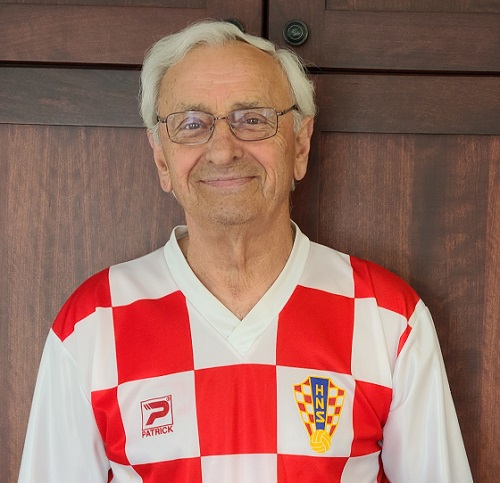
“They knew I was coming and I knew they were here.”
John Svalina (Sr) was but one of several hundreds of European immigrants who made their way to Sudbury through the 1950s and 1960s. Not only was the influx welcomed by the local soccer fraternity with open arms, it also created an absolute golden age for the sport in our region.
“They”, in the case of the now 77 year-old native of Dakovo (Croatia), specifically, was the Croatia Adria soccer club. “They knew all about me; people had talked about me, good, bad and in between.”
And so they should.
Twenty-three years of age as he made his way, on his own, from his home in Croatia, via Austria, to Canada, Svalina was one of the many who were completely immersed in the beautiful game from a very young age in Europe.
“Soccer was such a big part of our lives,” he said. “I remember it very well. I played soccer as soon as I could walk. Most of the kids in Croatia played soccer as soon as we could walk. Between the ages of six and ten, it wasn’t very organized, you were not coached very much - but they were looking for players.”
Think talent identification 101 is a much less formalized environment.
“Then it got very serious,” said Svalina. “You played juniors and you go from there, try and make it to the “A” team.” A talented ball handler with a decent scoring touch, the young man would find himself in the mix with the best of the boys from his own hometown.
“Apparently the people that took care of our soccer team figured I was good enough to make the team, so I guess that tells you I was OK.”
While many former athletes might have vague recollections of their start in the sport, Svalina recalls certain details with impressive accuracy. “As a junior player, I played on the left wing - number 11,” he stated. “I am a natural left foot, which gives me more exposure, more chances - it was hard to find left-footed players.”
Given his skill-set, it was no wonder than Svalina still romanticizes over an era of soccer where fans were ensured to be truly entertained. “My position was completely offensive, because the system we played there is completely different than the systems that you see now,” he said. “The system they play now is very defensive; the system that we played before was very offensive.”
Svalina was more than just a player; he was a fan of the game. Thankfully, there was no lack of access - even some fifty years before the arrival of the internet.
“I always wished that I could have played in Italy,” he said. “We used to get games from Rome every Sunday on TV. I loved the way they played, I loved the Italian people.”
What awaited him, on this side of the Atlantic, was a wondrous melting pot, one that truly embraced the game that he held dear.
"It was very good soccer in Sudbury, and the reason was simple: a lot of Europeans came to Canada at that time,” said the man who still recalls the date that his plane landed in Toronto (August 28th, 1966 - for those who are curious).
“Most of us had played the game, so when we got here, we were ready to go - Croatians, Italians, Polish, Germans, Ukrainians.”
Though the soccer days of his youth were spent out on the flank, Svalina would make a positional adjustment in his new home, as the local squad looked to maximize on what their new talent could bring to the table.
“Croatia Adria wasn’t the strongest team,” recalled Svalina. “They needed help and I wanted to help as much as I could, so I moved to the middle. Number 10, left inside. I tried to score more goals, and scored quite a few. I was better suited to play inside, just because I had the ball more, so I could do more.”
The simple truth is that a great many things were different in Canada than in Croatia. “Back in Croatia, it would take a miracle to move you from your position,” said Svalina. “Everybody just holds their position. They study it and they talk about it.”
By the time the seventies and eighties rolled around, Svalina had added coaching to his soccer repertoire, guiding the senior team that at one point included both of his sons - Michael and John. The transition, from on player talent to off-field observer, is seldom easy.
“Any player can only coach, at the beginning, based on the way that he played,” suggested Svalina. “You have to forget the way that you played and start all over again. You think about the kids only, then you can do it.”
It didn’t help that from a strategic standpoint, the notion of installing one striker at the top of the formation was soon going to become the norm. Suffice to say that Svalina is not a fan.
“You put one poor guy up there, it’s a miracle that he ever scores,” he said. “They play beautiful soccer now on the field, but to score a goal takes almost a miracle. When I was playing in my heyday, if someone told me that I was going to be the one guy up, I would say that I was going home.”
“I’m not Superman.”
That said, it’s not as though this soccer traditionalist is beyond garnering an appreciation for areas where improvement has been most noticeable. “Goalkeepers now are amazing,” said Svalina. “They were good before, but now, there are so many good ones, it’s unreal.”
Whether it is at one end of the pitch or the other, the game of soccer was the constant.
On many a September Labour Day weekend, Svalina would be reminded of the reasons why the sport had come to mean so much to him, partaking in the annual North American Crotian Soccer Tournament in venues that ranged from Toronto to Chicago, from Windsor to Milwaukee, from Cleveland to Sudbury.
“There might be two or three teams that cared about winning,” noted Svalina. “Everyone else would look for a nice cold beer and some sausages. It was a chance to get together with a lot of people that you get to know and play a friendly game.”
Such is the universal appeal of soccer, whether in Croatia or in Canada.
.







